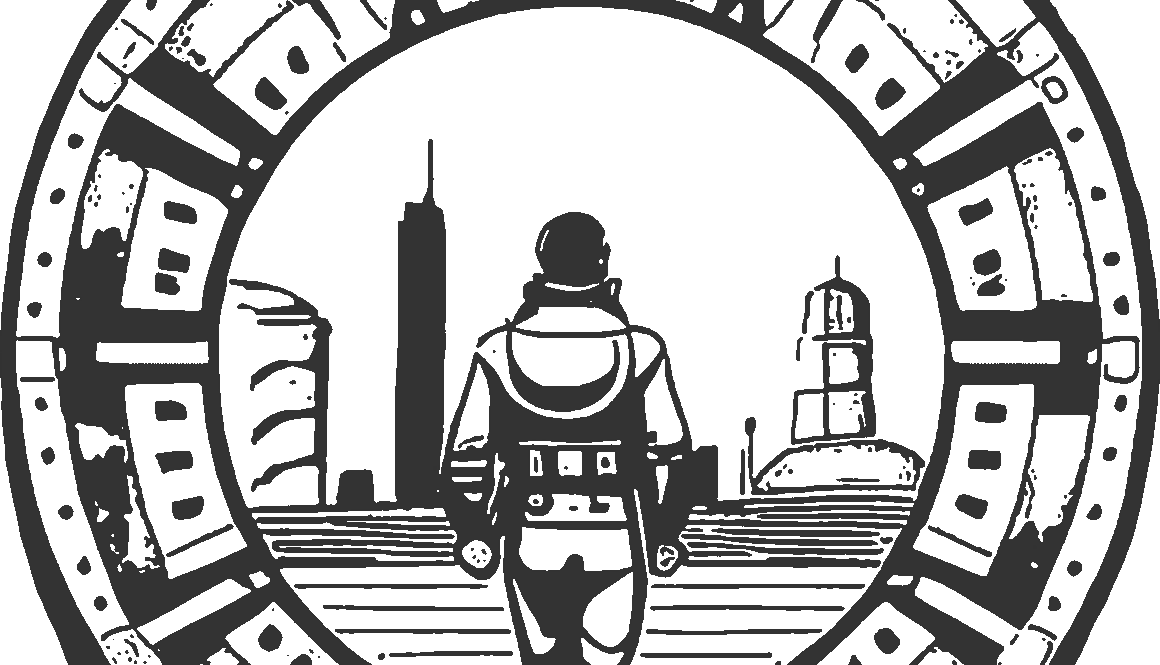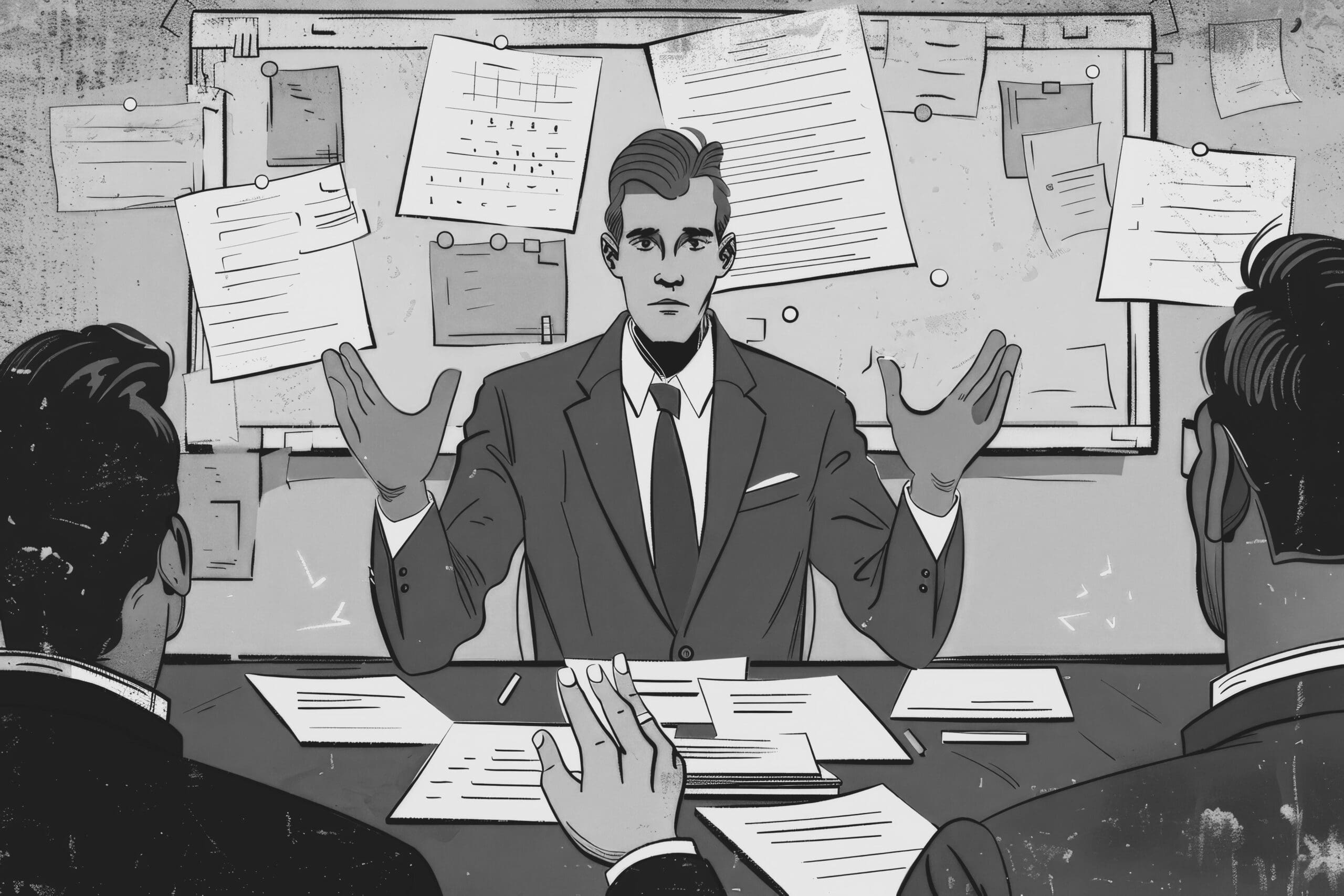The Org Chart Is Collapsing: Future Leaders Must Be the Glue Between Systems, Work, and People






This weekend I found myself enjoying time with a friend, and as we were talking, I had the opportunity to ask him about something he was working on for his company. Immediately I could recognize his excitement. As he told me about the project, his tone changed, the pace at which he spoke increased, and what was a casual conversation turned into passion.
It reminded me of something that this very same person said to me often or rather questioned: What do you find fulfillment in? From that, I started thinking about his career and those of the few others I’ve had the opportunity to work with who held positions where they were highly fulfilled in the work they did.
Far too often we still hear people say, “Find work that you love and you will never work a day in your life.” And although that may sound nice, how many of us can actually find work we love? Instead, I think we should take a page out of Justin’s book and focus on finding work that is fulfilling.
Fulfillment is something you can get from writing about leadership or helping someone change a tire. Fulfillment is obtainable. And you can find it in portions of your work and not others and as long as it’s in balance, you will continue to work, put in the extra effort, and do the little things that make you a great employee by all measures.
When I have had the pleasure of working with people that found fulfillment in their work, you could almost pick them out of a lineup. Almost always long-term employees, they move through processes and complete tasks with the grace of a ballet dancer and with what seems like no effort at all. They are a go-to resource for everyone, always willing to lend a hand, help someone, and support the team.
As a manager, high fulfillment can easily be misunderstood. This is an all-star player, so they must want to grow and develop, right? They must want to expand their role, take on new challenges, do other things, something. The truth? They likely don’t want any of those things. Your employees that find high fulfillment in their work are just that: fulfilled.
Fulfillment isn’t about promotion paths or fancy titles. It’s about the moments of alignment, when what you’re doing, how you’re doing it, and who you’re doing it with all click into place. That’s why some people thrive in roles that others would label “dead-end.” They’re not chasing the ladder; they’re content where they are, because the work itself delivers meaning.

But here’s the trap: organizations are really good at eroding fulfillment. A process gets changed, and suddenly the thing someone loved about their work is buried under bureaucracy. A manager comes in with a different agenda, and suddenly the employee who was once the go-to resource now feels sidelined. A company sets aggressive goals, and the extra weight crushes the joy that used to be in the job.
That’s why leaders have to pay attention. Don’t assume your most fulfilled people want more responsibility, a promotion, or a bigger paycheck. Sometimes what they want is simply to keep doing the thing they do best, without you “fixing” it. And don’t confuse their steadiness for complacency. They’re your cultural anchors the ones who show newer employees what good looks like, without ever saying a word.
The hardest part of managing for fulfillment is resisting the urge to meddle. You’ll be tempted to stretch these employees, “challenge” them, or move them into a new role. But more often than not, the best thing you can do is protect the environment where their fulfillment thrives. Give them recognition, respect their boundaries, and check in to make sure the processes around them aren’t chipping away at the joy they’ve built into their work.
Because here’s the truth: fulfillment drives performance more than passion ever could. Passion burns hot and fast; fulfillment endures. Passion makes you sprint; fulfillment keeps you lacing up your shoes day after day.
And if you’re serious about building a team that lasts, you don’t just measure sales, output, or retention you measure whether your people are actually fulfilled in the work they’re doing. Ignore that, and eventually the metrics you care about most will start slipping. Pay attention to it, and you’ll unlock a level of commitment and consistency you can’t buy with perks or paychecks.
—
So remember: Don’t ask your team, “Do you love your job?” That’s the wrong question. Instead, channel Justin and ask, “Do you find fulfillment in your work?” And when you hear the answer, protect it like it’s your most valuable KPI, because it probably is.

Not the employee.
Not you.
And definitely not your nervous system.
It’s the leadership moment no one trains you for, even though it’s one of the few things you will eventually have to do. And when that first time comes, you’re likely to overthink it, rehearse it in the mirror, run worst-case scenarios in your head, and still walk out feeling like you just kicked a puppy in public.
Everyone has a termination horror story or at least, it feels that way. In reality, we tend to dramatize what we thought might happen more than we admit the quiet truth:
“I just felt bad.”
I’ve come to believe this—
I’ve never actually fired anyone.
They fired themselves.
What I mean is, by the time it comes to letting someone go for performance, it shouldn’t be a surprise. They should already know they aren’t meeting expectations. They should understand exactly what needed to improve, and what the consequences would be if it didn’t.
But none of that changes the simple, sobering truth:
At some point, you will terminate someone’s employment.
And you will change their life.
Early in my career, the phrase “manage out” got tossed around a lot. It was the unspoken motto in an organization built on performance: you hit your targets, or you hit the road.
As a young manager, I didn’t think I could afford to carry low performers. And truthfully, some people just didn’t want to do the work.
Mike though; Mike was an interesting one.
High energy. Talkative. Proud of the work he did. Not exactly the kind of description that screams “he’s gotta go.”
But Mike just didn’t get it.
Our goals were clear. The company expectations were crystal. We had all the reports and metrics you could ever ask for. And somehow, with all of that, Mike still didn’t see it he wasn’t meeting expectations.
As his new manager, I saw the numbers. I knew we had a problem. But I also wanted to give him a shot. I thought if I could just show him what I and my leaders were seeing, I could help him rise to the challenge.
At our first team meeting, Mike came in confident, engaged, full of energy. He was upbeat. Vocal. Optimistic.
And I remember thinking, This is going to be easy.
I could not have been more wrong.
One of my first one-on-one interactions with Mike was when he was covering a territory for another employee. We met up to prep for a customer call, what should’ve been a focused, professional pre-call conversation.
But Mike came in like his hair was on fire.
The upbeat guy from our team meeting? Gone. The person who stood in front of me that day had nothing positive to say.
Well; let me clarify.
In hindsight, what Mike was doing was unloading. Word-vomiting every reason he wasn’t meeting his targets. Every systemic excuse, every team complaint, every external factor you could imagine. And I didn’t realize it right away but Mike knew he wasn’t getting the job done. So when he finally got his one-on-one with his new manager, he used it to steamroll me. Not just to excuse his own performance, but to cast doubt on the entire team.
And I bought it.
Keep in mind, he was saying all this while covering for someone else’s territory. Not even his own accounts.
So you can imagine my reaction.
No, you probably can’t.
The man writing this today would’ve handled that moment very differently. But back then? I let it shake me. I let his version of reality dilute my instincts. It softened my drive to hold him accountable and made me question whether I was seeing the situation clearly.
Luckily, that phase didn’t last long.
Once the dust from our first meeting had settled and I had time to do one-on-ones with the rest of the team, I started spending more time in Mike’s territory.
Each visit was more of the same.
He’d rant about how he couldn’t get the job done because he was always being pulled elsewhere covering, helping, being called in by others. The “why I can’t” list was endless. But now, I knew to ask better questions. And this time, I had scheduled multiple days with him.
Day One looked a lot like the last time I rode with Mike. In fact, it looked identical.
Same customers. Same route. Same talking points. Hmmm.
We had a few good interactions, found a couple of spots where we might be able to grow product volume, and by midday, Mike had finally run out of steam. That’s when the script repeated like your least favorite album starting over.
He started in again, this time adding that a teammate from another market, Tim, kept calling him for help. It was taking up all of his time.
Finally. An opening.
I thought I had the moment. I could show Mike how that off-district work was tanking his results. I could help him draw the line.
Nope. Not with Mike.
When I walked him through it, he lost it.
“Then why is Tim calling me?”
“Why do I have to go down there all the time?”
My answer? “You don’t.”
But Mike wasn’t having it.
“I can’t tell him no. I like Tim. He’s my friend. We have fun when I go down.”
I tried again. “Mike, that work isn’t your responsibility. It’s pulling you away from what you’re actually accountable for.”
He refused to hear it.
That night, after a brutal backseat meltdown from Mike, we wrapped up and I told him, “Let’s meet at the diner on 6th at 7:30 tomorrow. Bring your plan for the day.”
Mike just… went quiet.
That alarmed me. Mike hadn’t shut up all day. Silence wasn’t like him.
But he nodded. “Okay.” And left.
If Day One was confusing, Day Two was exhausting.
More excuses. More yelling. More talk about how he was being asked to do work that didn’t align with his role. I kept listening, but I also started pushing harder.
I showed him his schedule. His gaps. His misalignment. I connected his decisions to his results, using his own customer visits as evidence where people were saying things like:
“Oh wow, it’s been a while.”
“Nice to meet you, Mike.”
Nice to meet you?
That pushed Mike into overdrive. He doubled down. Said we didn’t understand the job. Said the company didn’t support the work. And when I finally showed him how to actually close a sale with a customer we’d already seen the day before he snapped.
“Why did you do that? You shouldn’t have asked him to buy those things. Now I owe him!”
I couldn’t believe it.
“What do you mean, owe him?”
Then came the final unraveling.
Mike started ranting about people worrying about him. About missing calls. About his girlfriend being upset because they hadn’t talked. He was spiraling. Fast.
By the time we got back to the diner where I’d left my car, I knew one thing with absolute clarity:
I wasn’t doing Day Three.
I’d audit the customers myself.
Call Tim directly.
Get the truth.
Honestly if I hadn’t seen it, hadn’t heard it all firsthand, I wouldn’t have believed it.
Following my instincts and digging deeper, it didn’t take long to understand why Mike was so upset. Why he “owed” people. Why he kept dropping everything to help Tim.
At some point, Mike had figured it out:
Helping in another market was the perfect excuse.
And he ran with it.
Yes, he did help occasionally. But it wasn’t because he was being asked. It was because he wanted to. The territory? New York City. He and his girlfriend would go down to the city and meet up with Tim. Go out. Have fun.
Tim, for what it’s worth, didn’t know what Mike was doing. He thought Mike was just tagging along. He didn’t realize Mike was using his name and his territory as a cover story to avoid doing his actual job.
And then came the customer visits.
Most of them? Couldn’t even pick Mike out of a lineup.
They were frustrated, with me, with the company, and with the empty promises they’d been handed. They hadn’t received the service they were promised.
The few that did know Mike fell into two camps:
“He’s great!”
Or: “He’s always asking for stuff.”
Turns out, Mike and his girlfriend would visit customers together, and try to barter. They’d offer company products or services in exchange for things they wanted personally.
I couldn’t believe it.
And as bad as it sounds, it got worse.
After Mike was terminated, I had to go clear out the storage unit he kept under the company’s name.
It was a scene straight out of National Treasure.
Piles of products. Unused assets. Promotional gear. Cases of chemicals. Thousands of dollars’ worth of company property stuff that never should’ve been in his possession jammed into a 10×30 unit.
He had somehow circumvented controls and built up an inventory that he used for personal projects, side deals, or to curry favor with customers. He’d turned a company job into a personal barter system.
By the end of the third day in his territory, it was already clear:
This wasn’t salvageable.
Mike didn’t need coaching.
Mike needed to be terminated.
And that’s exactly what happened.
I had been yelled at.
I had witnessed erratic behavior.
I had seen Mike lose it because we did the job and sold something to a customer.
So what was going to happen when I went to terminate him?
This is where so many leadership horror stories are born. The legendary “freak-outs.” A few of my favorites?
The salesman who drove through the front door.
The service tech who chased his manager to the car and punched the hood so hard it had to be replaced.
The terminated leader who took the company car on a joy ride… before getting arrested.
You’ve probably heard some version of those.
But here’s the reality no one prepares you for:
Most terminations aren’t explosive.
They’re quiet.
And they’re heartbreaking.
Because when someone realizes it’s really happening, the reaction isn’t always rage it’s vulnerability.
They tell you they need their job for a prescription.
They don’t know how to tell their spouse.
They break down and beg to stay.
And you, if you’re human, you feel all of it.
Not just for them. For the cost of the decision. For the weight of your role.
If you’re still reading this post, I’m guessing you care about the people you manage. So here’s your warning: even when it’s quiet, it can hit hard.
Mike, the angry, wild, irreverent employee—what was he going to do?
Would he scream at me?
Take the company car and vanish?
Make a scene in the parking lot of a burger joint?
I didn’t know. But I’d be lying if I said I wasn’t worried.
We did everything by the book.
I worked with HR. Documented Mike’s performance.
Communicated expectations. Gave him space to improve.
The process took over a month.
Then the day came.
First thing on a Friday, I drove to meet him. Documents in hand. Heart in my throat.
And to my complete surprise;
Mike barely reacted.
I told him it was time to part ways.
Handed him the paperwork. Asked if he had any questions.
He simply said, “No.”
Cleaned out his car.
Shook my hand.
Got in a taxi and left.
That was it.
I sat there feeling… everything.
Relief. Surprise. Even a little disappointment.
It felt too quiet. Too unresolved.
But it was done.
Later that day, the calls started.
Mike got home and started reaching out, questions I couldn’t easily answer. Stuff about benefits. Final pay. Health coverage. I wanted to help, but I stayed where I needed to:
“You’ll need to reach out to your HR rep. They’ll walk you through it.”
Then came the question that gutted me.
“What do I do now?”
I didn’t have an answer.
I just knew this:
Mike couldn’t work here anymore.
And that’s where my role ended.
It wasn’t until later that the gravity of it really hit me.
He knew it was coming.
He knew he hadn’t done the job.
But losing it still crushed him.
And that’s the lesson I carry with me to this day.
Every time I’ve had to end someone’s employment since, I ask the same questions:
Is this the right decision?
Have they been clearly told what success looks like?
Have they had a fair shot to get there?
What more can I do?
Because when the answer is nothing, that’s when it’s time.
I still believe this:
I’ve never fired anyone.
They’ve fired themselves.

In a recent Inc. article by Jeff Haden, Mark Cuban recently said something that caught my attention: the best employees are the ones who reduce their boss’s stress. Sure, intelligence, drive, and curiosity matter but stress reduction, he says, is what sets someone apart.
He’s not wrong. But he also isn’t telling the full story.
Stress reduction is a byproduct. It’s the result of something deeper at play, a mindset, a culture, a leadership philosophy. What Cuban’s really pointing toward isn’t about stress at all. It’s about problem solving. It’s about clarity. It’s about empowered employees who understand how to assess a situation, weigh the risk, and make a decision that aligns with the direction of the business.
In other words, Cuban is talking about leadership, but from the bottom up. And we need to unpack that. Before we get started let’s look at the example in the article Robbie. Robbie demonstrated a problem-solving mindset, we knew the conveyor was an issue and that he needed an electrician to fix, he knew he would have a staffing shortage in the future and developed another employee. He noticed the shift in Doug and escalated it appropriately. This isn’t a demonstration of stress reduction this is the outcome of a leader that empowered his team member to, demonstrated and coached them on how to make decisions.
What Stress-Reducing Employees Are Really Doing
Let’s be clear about what’s actually happening when a great employee “reduces stress.” They’re not just calm under pressure or pleasant to be around, they’re absorbing complexity. They’re making good decisions on your behalf. They’re catching problems before they escalate. And, perhaps most importantly, they’re operating with just enough confidence and clarity to act independently without overstepping.
That kind of performance doesn’t happen by accident.
It’s tempting to view it as a natural personality trait this employee just “gets it.” But in most cases, what you’re seeing is the result of either deliberate coaching or, frankly, previous experience under a strong leader. These people have learned how to interpret ambiguity. They’ve learned how to break down a problem, consider implications, and act with intention. And they’ve learned when not to act, which is often just as important.
When employees like that are on your team, you feel it. Your inbox is quieter. You don’t find yourself double-checking things that were supposed to be done. Conversations stay focused on outcomes, not excuses. Meetings feel like progress, not posturing. That’s what stress reduction actually looks like not because someone’s stress-free, but because they’ve learned how to carry weight. It’s easy to feel like these employees don’t need support or even overlook them because your focused on the employees that do cause stress; don’t fall into that trap. The steady eddies should get more attention than your weakest performers. These employees don’t always lead like Robbie. Often they quietly get the job done solving problems, feeling empowered to make decisions as needed and with exceptional alignment with leadership direction and company goals. As a manger these “A” players that get high fulfillment in their current role are you most valuable. And from my experience the most overlooked or undervalued. In fact, I would argue that many managers and Senior leaders would calls these employees “B” players. Why? Because they aren’t hard drivers to grow and develop. Instead, they are adaptive and conscientious, they deliver on target consistently without excuse. The long and short of it don’t fall into the trap of ignoring your real ”A” players because someone else is creating issues, or a hard driver.
Now lets get back to Stress –
Stress Isn’t the Problem. You Are!
If you’re a leader constantly feeling overwhelmed, it’s easy to blame it on external stressors: the market, the workload, the noise. But often, the real issue is your leadership. When a team doesn’t know where the lines are what decisions they’re allowed to make, how to escalate issues, or what success looks like they default to inaction. And when they default to inaction, everything lands on your desk.
That’s not a stress problem. That’s a leadership problem.
The most powerful leaders I’ve worked with or developed weren’t the ones who could do everything themselves. They were the ones who created the conditions for other people to think and act independently. They didn’t just manage tasks they cultivated judgment. They taught people how to interpret the business environment, make contextual decisions, and speak up when something didn’t feel right.
When you lead that way, you don’t just get results. You get trust. And when you build trust, stress naturally starts to recede, not because the work gets easier, but because the burden is shared by people who are fully equipped to carry it.
How You Actually Build That Kind of Team
This is where many leaders struggle. We say we want empowered teams. We say we want people to take initiative. But the moment someone makes a mistake or veers from our preferred path, we punish the attempt.
Empowerment without permission is just a trap.
If you want people to solve problems and reduce stress, you must create a culture where they are encouraged to use judgment. That begins with giving them the opportunity and supporting them when a decision is different from what you think, or goes wrong.
I’ve always taught my teams to operate around three simple questions:
This doesn’t mean you’ll get perfect answers every time. But it does mean you’ll get thoughtful ones focused on alignment with goals and company initiatives. Over-time, your teams will learn from you. Expect early on that you will get lots of questions, don’t be afraid to push back and ask, “What do you think?”. Doing so will provide coaching opportunities on problem solving while aligning thought processes. I encourage you to look for opportunities to do something differently than you originally thought. Usually quickly you will find that your team members learn how to think through a challenge. They start becoming the person Cuban is describing. Not just smart. Not just talented. But reliably effective.
That’s how problem solvers are born.

Stop Looking for Stress Relief. Start Building Better Thinkers.
I’ve worked with teams where stress was everywhere. I’ve also led teams where stress didn’t go away it just stopped being contagious. The difference? In the high-functioning environments, people weren’t waiting on direction. They were moving. Thinking. Deciding.
That’s what we should be talking about not the vague aspiration of “less stress,” but the tangible leadership behaviors that create clarity and confidence in the people around us.
Cuban’s right: if you’re creating stress for your boss, you’re probably not as valuable as you think. But if you’re solving problems before they reach your boss, if you’re empowering others to act, and if you’re moving the business forward with quiet consistency—then you’re not just reducing stress.
You’re leading.
And that’s the skill we should be teaching.

There’s a special kind of wisdom that only comes from falling flat on your face in front of your boss, your team, or a packed conference room while trying to pretend you meant to trip over your own PowerPoint clicker. That kind of wisdom doesn’t come from books. It comes from mistakes loud, public, slightly traumatic mistakes that leave just enough scar tissue to become a leadership lesson.
I’ve made a few. Okay, more than a few.
In my early leadership days, I treated mistakes like bruises uncomfortable, avoidable, and best covered up. But over time, I started treating them like receipts. Every one was proof that I was in the game, learning the rules the hard way.
This post isn’t a confessional. It’s a favor. These are the mistakes I hope you don’t repeat not because you’re smarter than me (though you probably are), but because you deserve to spend less time redoing things that don’t work and more time building things that do.
Some of these mistakes are common. Some are a little too personal. All of them are expensive if ignored. So grab a coffee, a notepad, or some shine depending on what hour it is and let’s talk about six of the dumbest leadership moves I made so you don’t have to.
The high-performing salesman who burned down our culture
If I could sum up this lesson in one line, it’d be: “Sometimes the wolf you let in is wearing a suit but it’s monogrammed, and the initials are E.G.O.”
Let me introduce you to a guy I hired early in my professional leadership journey. We’ll call him Max, mostly because “Walking Red Flag” feels too on the nose.
On paper, Max was a slam dunk. Former top salesperson. Big energy. Said all the right buzzwords. He knew how to handle objections, close business, and he had that kind of bravado that makes recruiters weak in the knees. I should’ve run the moment he referred to himself in the third person, but I didn’t. (All jokes aside) I had targets to hit and I wanted to win and needed a strong proven sales professional – that wasn’t Max.
Max got the job.
And to his credit he did perform. At least, if your only metric of performance is revenue and chaos isn’t on the dashboard.
But from day one, the problems started to show. Max didn’t just bring his talent he brought a Saturn sized ego. He thought operations existed to slow him down. He treated account managers like personal assistants. Meetings weren’t discussions; they were one-man TED Talks. And when someone disagreed with him, it was less “let’s find alignment” and more “how dare you challenge the king.”

Execution suffered immediately. His promises to customers didn’t line up with what we could actually deliver. Our ops team was scrambling to make up for his cowboy-style commitments. Meanwhile, morale in the department dipped like a rollercoaster with loose bolts.
Here’s the kicker: Max wasn’t dumb. He just didn’t care about anyone else’s job. He saw success through the narrow lens of “I sell, therefore I win.” And he couldn’t, or wouldn’t, understand that we relied on each other for success. He refused to build with us. Instead he eroded the foundation we stood on.
I pulled him aside multiple times. Tried the coaching route. Gave him direct feedback. Asked him to collaborate. He always nodded, threw around a few buzzwords like “synergy” and “team buy-in,” and then returned to treating every cross-functional partner like an obstacle to overcome.
The team started to check out. They avoided him, delayed projects, and vented in hushed tones behind closed doors. I knew something had to be done because I could see the Max fatigue from the rest of the team.
And that’s when it hit me: I had hired someone who sold well but cost us everything else.
Look, we all make hiring mistakes. But this one taught me something foundational: a single person can produce results and still be an organizational liability. Especially when they treat collaboration like a speed bump and see their coworkers as competition.
The worst part? I had seen glimpses of this in the interview process. He cut me off mid-sentence once to correct a detail I didn’t need corrected. He laughed a little too hard when I asked about past failures. He dodged questions about team dynamics by telling me how amazing he was.
It was difficult to trust my gut back then, so with his background and the needs of the District I made the call.
So here’s the hard truth I had to learn: high performance doesn’t excuse low character. And it doesn’t justify hiring someone who can’t or won’t play well with others. Culture isn’t a perk it’s the operating system. And if one line of corrupted code walks in wearing polished shoes and a nice watch, the whole thing crashes.
Eventually, I had to let Max go. Not because of sales numbers, but because of what those numbers were costing us everywhere else. The day he left, the team breathed again. It was subtle, but real like we had finally stopped bracing for impact.
These days, I don’t just look for skill. I look for self-awareness. I look for people who know the job and the company aren’t just about them. If someone can’t describe a team win without using the word “I” eight times, I move on.
Because building a high-performing team means hiring people who elevate others not just themselves.
It’s actually about trust! And trust is built in the hard moments
I used to think leadership was about getting people to like you… or at the very least, listen to you because of your title.
Spoiler: It’s neither.
There was a time early in my career when I swung between two extremes: I either wanted to be the team’s favorite sibling relatable, supportive, easy to talk to; or I tried to assert authority with the classic “I’m the boss, that’s why” approach. It was a real leadership rollercoaster, and it led me to a place where I thought I would gain respect by out working everyone on my team. Shocking as it sounds that didn’t work either.
When I tried to lead through friendship, I’d didn’t avoid hard conversations. but I would downplay the issues. I’d give my team too much space even if they were clearly struggling or creating friction because I didn’t want to “hurt the relationship.” I thought that friendship would encourage people to do the right thing, the hard work.
It didn’t.
And when I swung the other way and tried to lead with pure authority, it was worse. I would make commands with little insight, adjust peoples schedules before speaking with them. Commit team members to additional account visits or site walks. I made decisions in isolation and expected the team to just roll with it. Roll they did right past me on their way out the door.
After struggling leading my first team for sometime, working 10-12 hours a day because if I did it they could too. Because if I worked more than them they would respect me. Because if I wanted to lead them i had to be the best. A pivotal moment struck, I was faced with a situation that required me to admit my mistake take ownership of what happened and deal with a team member that was impacted because I hadn’t been a great leader. The outcome: I gained his trust, and respect. That’s when everything changed and I learned that leading is about Trust. Authority and Friendship cant do what trust can do.
And trust isn’t built during the easy weeks. It’s built when things go sideways. When the customer is furious, when the deadline is a flaming mess, or when a team member screws up and you don’t throw them under the bus.
Trust is built when your team knows:
You’ll give them the truth, even if it’s uncomfortable.
You’ll fight for them when it counts.
You’ll own mistakes instead of dodging them.
You won’t disappear when the heat gets turned up.
Another example: I had an account manager under me who made a pretty serious error that cost us a deal. It would’ve been easy for me to shift the blame onto him entirely, especially because he was the final step before things went wrong. But the truth was, I hadn’t provided enough guidance or feedback leading up to that point. I’d been too hands-off, assuming he had it covered.
So instead of letting him take the fall alone, I took the hit with with our team and our leadership team and owned my part. I could see the impact this had on my team immediately. They saw that I wasn’t just there to bask in the wins I was there to shoulder the losses, too.
That moment bought me more credibility than a year of pep talks and free pizza ever could.
Now don’t get me wrong: trust doesn’t mean softness. It doesn’t mean you let things slide or avoid accountability. But it does mean being willing to walk into tough moments with your team and not around them. It means facing issues head-on instead of hiding behind titles or pretending everything’s fine.
Eventually, I learned that trust grows in the exact moments most leaders avoid—when you have to say, “This isn’t working,” or “We need to talk about something difficult,” or “I don’t have all the answers, but I’m going to figure it out with you.”
That’s leadership. That’s where trust lives.
So, if you’re out here trying to win people over with charm or control them with a title, let me save you some heartache: it doesn’t work. You’ll either burn yourself out trying to be everyone’s buddy, or you’ll alienate your team by swinging the command-and-control hammer too hard.
Instead, get good at building trust. Learn how to say the hard thing with respect. Show up when it’s uncomfortable. Share credit. Own failures. Admit when you don’t know something.
Trust doesn’t require perfection, it just requires presence, consistency, and a little courage.
You don’t need to be liked. You don’t need to be feared. You need to be trusted.
That’s what people follow.
Why being the hero isn’t always helpful
If you’re a leader and you’ve never felt like a firefighter, congratulations—you might be the first. For the rest of us, there’s that adrenaline rush of jumping into chaos, stomping out the flames, and emerging with soot on your face like, “See? I saved the day.”
For a long time, I thought that was leadership.
I thought being the first one on the scene, solving the problem, and getting everything “back on track” was the gold standard. After all, the more fires I put out, the more valuable I must be… right?
Spoiler: wrong. So wrong.
The truth is, the more time I spent fighting fires, the less time I spent figuring out why things kept catching fire in the first place.
At one point in my career, I was practically living in crisis mode. Every issue—whether it was a customer complaint, a missed delivery, or a frustrated teammate—got my full, immediate attention. I’d drop everything to fix it. I’d send the emails, make the calls, patch the process, calm the customer.
And you know what? The team loved me for it. At first.
“Travis handles it.”
“He always has our back.”
“He’s the one who gets stuff done.”
It felt good. I felt needed. Useful. Heroic, even. But here’s the problem with always being the firefighter: you never actually stop the fires from happening.
I was putting on a performance, not leading a transformation.
Eventually, the same issues started popping up again. And again. Because while I was busy throwing water on the flames, I wasn’t fixing the faulty wiring that kept setting the place ablaze.
Worse, I had unknowingly trained my team to depend on me for everything. Why take ownership of a broken system when they could call me and I’d fix it? Why work through tension with another department when they knew I’d jump in and smooth it over?
I wasn’t empowering them—I was enabling them.
And here’s the kicker: I started to burn out. The more I firefought, the less strategic I became. I was constantly reacting, never proactively planning. And the business? It stayed stuck in a holding pattern because we never actually evolved—we just survived.
One turning point came during a particularly chaotic month. Three major client issues hit back-to-back. Each one could’ve been prevented. But instead of addressing the root causes—bad handoffs, unclear responsibilities, and a lack of follow-through—I dove in like usual and muscled through them.
We hit our targets that month. But we lost a great team member who felt overwhelmed and under-supported. And I lost a bit of my edge because I was too deep in the trenches to see the bigger picture.
That’s when I realized: it’s not enough to solve problems. Real leadership means preventing them.

So I started shifting my mindset. Instead of asking, “What needs to be fixed today?” I started asking, “Why does this keep happening?” I created space to zoom out, analyze patterns, and bring the team in to fix systems—not symptoms.
We mapped workflows. We clarified roles. We added some simple process guardrails that kept common issues from spiraling out. And you know what? It wasn’t sexy. It wasn’t dramatic. But it worked.
The fires didn’t disappear overnight. But they stopped feeling like emergencies. They became signals—early warnings that helped us course-correct before we needed a full response team.
And perhaps most importantly, the team grew. Because when I stepped back from being the hero, it created space for them to step up.
So here’s my advice if you’re still in firefighting mode: take off the helmet. Put down the hose. And stop pretending your calendar full of emergencies is proof of your importance.
Instead, lead like a forest ranger. Look at the whole ecosystem. Ask hard questions. Solve root problems. Train others to spot the sparks before they become infernos.
You’re not here to save the day.
You’re here to build a better one
Because a full calendar isn’t the same as a full impact
For a long time, I was proud of how “busy” I was. I had the color-coded calendar, the back-to-back meetings, the overflowing inbox, and the classic leadership posture of speed-walking down hallways like I was late for my own deposition.
I genuinely thought it meant I was killing it.
Busy meant important, right? Busy meant productive. Busy meant leading.
Except it didn’t. What it really meant was: distracted, disconnected, and occasionally one Starbucks away from a nervous episode.
The truth hit me the way most leadership truths do, after a few polite warning signs and one not-so-polite reality check.
Let me set the scene: I was leading a sales team and juggling about 87 tasks per hour. We were chasing aggressive growth, onboarding new customers, managing legacy ones, and I was in “always-on” mode. I had fallen into that trap where you think leadership means being available 24/7, solving everything instantly, and measuring your worth by the number of Teams calls you survive in a day.
And I wasn’t the only one. My sales team was doing the same thing. They were working their tails off, crushing hours logged, calls made, emails sent. From the outside, we looked unstoppable. And we were hitting targets. Being highly active was working; or was it?
My reps were logging tons of activity but not building real rapport with clients. They were transactional, not relational. And I was no better. I had stopped having regular check-ins with half my team. I watched the metrics and let it guide who I spoke to.
One rep finally told me, “Travis, I feel like i only hear from you when I need to do something or I need to improve”
That cracked my shell.
So I took a step back. I looked at how I was spending my time, and more importantly, how it was felt by the people who reported to me.
And what I realized is this: busyness is not a badge of honor—it’s a warning sign.
It’s what happens when you fill your days with motion instead of meaning. When you confuse speed with direction. When you manage a team by spreadsheet and forget that actual people are attached to those metrics.
I started making time for conversations again. Not just updates or standups but real, human conversations.
“What’s working for you right now?”
“Where are you stuck?”
“How’s your energy this week?”
“What’s one thing I can take off your plate?”
Nothing revolutionary. Just consistent, honest check-ins that weren’t about tasks they were about my team.
Same with customers. I asked the sales team to slow down and focus on quality. Not five emails a day but instead thoughtful conversations. Not “just touching base” emails but “here’s how we can help” solutions.
And guess what? Things got even better!
Customers felt heard. The team felt supported. And I—shockingly—felt less stressed because I wasn’t spinning in circles chasing tasks that didn’t actually move the needle.
Now when I see a packed calendar, I don’t automatically assume someone’s effective. I ask, “Are you actually connecting with your people? Are you creating space for strategy? Are you thinking, or just reacting?”
Because effectiveness isn’t how much you do, it’s how much matters.
Leadership isn’t won by getting your inbox zero or the most meetings attended. It’s earned by clarity, communication, and making the people you lead feel like they matter more than your calendar.
So if you’re too busy to talk to your team this week, or too buried in emails to hear what a customer is trying to say; pause. Look up. Take back control of your time.
Because nobody builds a legacy out of being “busy.”
They build it by being present.
The longer you wait, the messier it gets—just ask Josh
Let me level with you: Hard Conversations are almost always worse in your head than in reality.
As a younger leader, I hadn’t realized that yet, so I would delay, over prepare or even just glaze over challenging topics. I believed that if I just gave things time, they’d work themselves out. That people would “get the hint.” That issues would smooth over with enough positive reinforcement, pep talks and KPI reviews.
And sometimes, sure, that works. But more often, avoiding the hard conversations just gives small problems time to become BIG ones.
Let me introduce you to Josh. Josh was the walking, vaping embodiment of why avoidance doesn’t work.
Josh was a new hire who came in confident borderline cocky, if we’re being honest. He talked a big game, showed up with enthusiasm, and assured everyone he was going to “own his territory.”
Spoiler: the only thing he owned was a vape pen and a shocking amount of self-delusion.
Almost immediately, Josh started missing the mark. He skipped customer visits. He ignored sales goals. His communication was thin, and when it did happen, it usually came with a side of sarcasm or thinly veiled condescension.
And then, the pièce de résistance: he vaped during meetings.
Yes. Meetings. As in, during team calls, mid-discussion, casually exhaling like he was headlining a jazz club.
Now, you’d think that would’ve triggered an immediate correction. But no I delayed. I rationalized. I convinced myself he just needed time to adjust. That he’d come around. That addressing things too soon might “discourage him.”
What I didn’t realize was that my silence was permission.
By not saying anything, I told Josh, loud and clear, that what he was doing was fine.
And he believed me.
So when the time finally came to sit him down and explain that he was missing expectations, underperforming, and actively frustrating the team he was shocked. Like deer-in-a-LED-headlight shocked.
Because I had let him walk around thinking everything was great for weeks.
And that was on me.
He didn’t take the feedback well. In fact, it went sideways fast. He got defensive, combative, and refused to take responsibility. And while yes, that reaction told me a lot about Josh, it also told me something uncomfortable about myself:
I had waited too long.
And that’s the bigger mistake here, not hiring Josh, not even the vaping (though wow) but waiting. Waiting to be honest. Waiting to provide clarity. Waiting to lean into a conversation I knew needed to happen.
This happens to so many leaders. We tell ourselves we’re giving someone “space” when really, we’re just avoiding discomfort. We’re scared of confrontation, scared of emotion, scared of making things awkward.
But awkwardness now is better than a disaster later.
Here’s what I’ve learned (the hard way):
Early clarity prevents late-stage conflict.
Avoidance isn’t kindness it’s confusion.
Accountability conversations don’t get easier they get heavier.
And ironically, most people actually appreciate the directness if it comes with respect and a genuine intent to help.
Now, I don’t wait. If there’s a misalignment, I speak to it early. Not with aggression. Not with shame. Just with clarity. “Here’s what I’m seeing. Here’s what’s expected. What support do you need to get there?”
It’s not about being harsh, it’s about being honest.
Because the cost of avoidance is never just one person.
It spreads. It tells your top performers that mediocrity is tolerated. It erodes trust. And it makes every future conversation harder because you’ve trained people not to expect honesty from you.
So if there’s a Josh in your world right now; maybe not vaping, but definitely missing the mark. Ask yourself this:
Have you been clear? Have you had the real conversation?
Or are you just hoping it’ll fix itself?
Because it won’t.
And the longer you wait, the more dramatic it gets.
Fair doesn’t mean equal. It means human.
If you want to watch a team slowly disengage, just start handing down decisions without explaining them. Add a dash of blanket policy enforcement, top it off with a “that’s just how we do it,” and boom instant morale killer. Serve cold with a side of turnover.
Its easy to make this mistake, especially early in the leadership journey We tend to focused on structure, consistency, and keeping everything neat and predictable. We want everything to be fair. What I didn’t realize was: equal isn’t fair. Equal is uniform. Fair is personal.
Let me explain.
Back then, I believed I had to treat everyone the exact same way in order to be seen as a good leader. Same rules. Same style. Same communication. Same management approach. That felt safe. Impartial. Clean.
But people aren’t clean. They’re complex, layered, and wildly different in what drives them. Some are motivated by recognition, some by autonomy, some by a clear career path, and some just want to get home in time to make dinner and not be micromanaged into a coma.
And if you don’t understand that, if you don’t take time to learn what actually matters to each person, you’ll miss the mark. Even if you think you’re being “fair.”
For example, I once had two high-performers on my team. One was very private, highly independent, wanted space to work, and just needed the occasional acknowledgment that they were doing a good job. The other craved collaboration, mentorship, and regular feedback, they needed to feel connected to the mission and the team.
So what did I do?
I treated them both the same.
I gave them identical goals, the same cadence of check-ins, the same bonus structure. I figured, “If it’s fair on paper, it’s fair in practice.”
Spoiler: it wasn’t.
One quietly burned out. The other started shopping their resume. And both eventually sat me down and said some version of, “I don’t feel seen here.”
That one hurt. Because I liked them. I thought I was doing the right thing. I thought I was being fair.
But fair isn’t giving everyone the same thing. It’s giving people what they need to succeed.
And that starts with understanding why they’re here in the first place.
This brings me to the second part of the mistake: not sharing the “why.”
People will do a job. They’ll show up, follow instructions, and hit the numbers, at least for a while. But if they don’t understand why something matters? If they don’t know how it connects to the bigger picture, or how it helps the customer, or how it advances the mission, they won’t bring their best.
They’ll bring compliance. Not commitment.
I’ve made decisions before, about territory realignments, sales strategy shifts, or even team restructures, where I thought, “This is clearly the right move.” And maybe it was. But I failed to bring the team into the decision-making process. Or I didn’t explain the rationale well. Or I shared the what without the why.
And when that happens, even the best ideas land with suspicion.
Suddenly it’s not strategy, it’s politics. It’s not leadership, it’s micromanagement.
You lose trust, not because you made the wrong call, but because you made a quiet one.
These days, I slow down before rolling out a change. I explain it. I give context. I invite questions. Not because I need permission, but because people deserve understanding.
I also make it a point to ask every team member, “What do you want out of your time here?” Not in a cheesy HR kind of way, but with real intent. Some people want to grow into leadership. Some want stability. Some want to learn new skills. And guess what? When you tailor your approach to those goals, when you lead like a human being instead of a policy manual you unlock potential you didn’t even know was there.
Bottom line?
Don’t treat everyone the same, treat them with the same level of intentionality.
Don’t assume silence means agreement.
And don’t just hand people the “what.”
If you want buy-in, give them the why.
Because when people understand their role, believe in the purpose behind it, and feel like their unique needs are recognized you don’t have to push them.
They’ll pull you.

If there’s one unifying theme across these six mistakes, it’s this: leadership isn’t about avoiding missteps, it’s about learning, adjusting, and not dragging a whole team through the same hole twice.
I’ve hired the wrong person because I chased performance over fit.
I’ve led with authority and friendship before I earned trust.
I’ve worn the firefighter cape like a badge while ignoring broken systems.
I’ve confused motion for meaning and filled calendars instead of connection.
I’ve avoided hard conversations until they exploded in my face.
And I’ve treated everyone the same in the name of fairness, only to lose what made them unique.
Each one of these mistakes came with a price, sometimes in budget, sometimes in morale, sometimes in sleep. But they also came with growth. And that’s the part I wouldn’t trade.
The truth is, you’re going to screw up. So am I. The goal isn’t perfection it’s awareness. Self-awareness. Team-awareness. Situational-awareness. Because if you can name the mistake, you can fix it. Or at least keep it from becoming your brand.
If you’re a new leader, take this post as a heads-up from someone who’s stepped on the rake more than once. And if you’ve been leading for years, consider this a gut-check: are you still making these mistakes? Are you justifying them because “that’s how we’ve always done it”? Are you willing to try a better way?
Leadership is a long game. And the best leaders aren’t the ones who avoid mistakes, they’re the ones who outgrow them.
So go ahead: mess up. But mess up with purpose. And when you do, pull your team in close, own it, and say the most powerful sentence in leadership:
“That one’s on me. Let’s make it better together.”
Thanks for reading. Now go lead like you’ve made a few mistakes and learned something from every single one of them.

Life and business are filled with challenges. Over the course of my career, I’ve encountered difficult times that tested my resilience, forced me to innovate, and ultimately helped me grow as a leader. Among these challenges, the 2008 financial crisis and the COVID-19 shutdowns stand out as defining moments that taught me to view problems not as obstacles but as opportunities to accelerate forward.
This mindset shift from seeing problems as roadblocks to reframing them as opportunities has become a guiding principle in my leadership style. It has helped me not only weather the storms of economic downturns but also thrive in environments where others faltered. These experiences serve as powerful reminders of how challenges, when approached with creativity and determination, can lead to unexpected growth.
The Financial Crisis of 2008: Leading Through Uncertainty
In 2008, I was in a commission-based sales role. My customers were directly impacted by consumer spending, and as the financial crisis took hold, sales plummeted. Consumer confidence evaporated, and businesses tightened their belts. My livelihood was at stake, and I was faced with an unsettling question: How do we stay on track when the market we serve is shrinking at an alarming rate?
At the time, I was a relatively new leader. I had no experience navigating a major economic downturn, and I’ll admit, I was terrified. My team looked to me for guidance, and I didn’t have all the answers. People depended on me, not just for direction but for their livelihoods. It was a humbling moment.
During that difficult period, I leaned into a piece of advice I had heard: “Every problem is an opportunity.” This phrase, which I later traced to President John Adams, seemed almost trite at first. But as I reflected on it, the simplicity of the idea struck me. Problems are opportunities—not in the sense that they are easy to solve, but because they force you to think differently, to innovate, and to act decisively.
I realized that instead of panicking or cutting corners, I needed to focus on what I could control. For my team and me, that meant doubling down on the fundamentals: taking exceptional care of our existing customers and working harder than ever to build new relationships.
A Bold Strategy That Paid Off
While many of our competitors reacted to the downturn by slashing prices and reducing staff, we chose a different path. We maintained our focus on value, training customers to get the most out of our products, and expanding our offerings to meet their needs. We made the deliberate decision to stay the course, trusting that our consistent approach would build trust and loyalty.
At first, it was tough. Sales declined, and the pressure was immense. But over time, our strategy began to pay off:
By staying focused on our core principles and refusing to compromise on quality or service, we not only weathered the storm but emerged stronger. When consumer spending eventually rebounded, we were well-positioned to capitalize on the recovery, leaving our competitors struggling to regain their footing.

COVID-19: A Crisis Amplified
Fast forward to 2020, and I found myself facing another massive disruption—this time as both a business owner and a Sales Manager. The COVID-19 shutdowns created an unprecedented level of uncertainty. Entire industries were upended, and businesses scrambled to adapt to a rapidly changing environment.
For me, the challenge was even greater because I was managing two roles simultaneously. On one hand, I needed to sustain my own business; on the other, I was responsible for leading a team through the chaos. Once again, the question loomed: How do you drive sales when the market is shrinking and your customers are facing their own existential challenges?
Leaning on the lessons I had learned in 2008, I embraced the mindset that problems are opportunities. While competitors panicked and pulled back, I focused on how we could pivot to meet our customers’ evolving needs.
Staying the Course in Uncharted Waters
At first, the situation looked bleak. Clients were unresponsive, and new business seemed impossible to secure. But rather than succumbing to fear, I encouraged my team to keep working. We reached out to customers daily, left messages, sent marketing communications, and demonstrated that we were ready and available to help.
Then, a turning point: after weeks of silence, the phones started ringing. Customers began reaching out with urgent requests, asking for solutions to help their employees work from home. Suddenly, the challenges we had faced transformed into a windfall of opportunity.
The results were extraordinary:
The most common feedback we received from new customers was simple: “You answered the phone.” While competitors struggled to adapt, our consistent presence and proactive communication made us a trusted partner in a time of need.

Lessons in Resilience and Leadership
The experiences of 2008 and 2020 taught me that success in challenging times requires a combination of resilience, adaptability, and a willingness to see beyond the immediate problem. In both cases, the actions we took were guided by a few key principles:
Turning Problems into Opportunities
Looking back, the crises of 2008 and 2020 could have been devastating. Instead, they became defining moments in my career. By embracing challenges as opportunities, I was able to lead my teams through adversity and achieve outcomes that exceeded expectations.
This mindset that problems are opportunities in disguise is more than just a leadership philosophy. It’s a way of approaching life and business with curiosity, creativity, and courage. When you look at challenges through this lens, you’re not just solving problems; you’re building the future.
Every problem, no matter how daunting, holds the potential for growth. It’s up to us to seize that potential and turn adversity into achievement. In my experience, the rewards are well worth the effort.

Let’s rewind to my first real leadership role; retail. That magical world of folding shirts no one would buy, dealing with coupons that expired in 2007, and managing a schedule that could change three times in one shift.
In retail, hiring was a volume game. It had to be. You’d post a “Now Hiring” sign, bring in ten people, and cross your fingers that maybe two of them would still be showing up after the first week. The others? Ghosted. Vanished. Gone before the first timeclock punch. One girl didn’t come back after lunch. One guy quit because we asked him to move a box.
So yeah, we hired fast. We had to. Warm bodies were better than no bodies, and if someone stuck it out for a full pay cycle, we celebrated like they hit a five-year milestone. I treated hiring like a bulk buy at Costco grab a bunch and and anyone worth it would stick it out.
And back then, it sort of worked.
But retail turnover is expected. It’s part of the model. The stakes are low, and the cost of a bad hire is usually a few hours of re-training and a slight dent in morale.
Then I left retail.
When I transitioned into managing roles that actually mattered the ones that affected customer relationships, revenue, brand reputation, and team dynamics. I realized quickly: the high-turnover strategy from retail doesn’t work when the job actually matters.
Unfortunately, I had to watch as others made this mistake for me.
I did something a little rare for a first-time leader stepping into higher-stakes hiring: I observed. I watched how others approached it. And what I saw made my eye twitch.
It was like retail all over again, except worse. I saw managers hire on impulse. One interview. One handshake. One gut feeling. No real vetting. No culture consideration. Just “I like them. They start Monday.”
Sounded familiar, but this time, the jobs weren’t about stocking shelves they were running projects, managing accounts, or interfacing with clients. These weren’t throwaway roles. These were the people who could tank an initiative or turn a happy client into a lawsuit with one bad email.
And guess what? The fallout was brutal:
Team performance cratered.
Morale took nosedives.
Customer complaints piled up.
And managers? They were too busy rehiring to actually lead.
I took note mentally and sometimes literally. Every warm-body hire that turned into a flameout confirmed what I already suspected: rushed hiring is a long-term liability disguised as a short-term solution.
So I did what any stubborn, mildly-traumatized-from-retail leader would do I went the other way.
Let me be honest slowing down the hiring process didn’t make me any friends in the “we need help now” crowd. Some leaders grumbled. A few peers questioned my sanity. And yes, there were moments when I was short-staffed and seriously considered recruiting from my local Tim Hortons just to get some relief.
But I stuck to it. Because I knew the real cost wasn’t a longer hiring window it was redoing the same hire two or three times. I wasn’t interested in running a hamster wheel. I wanted to build a team that could walk in, find their lane, and run.
And over time, that’s exactly what started to happen.
New hires quitting after 3 week or months…
Customers asking, “Do you have anyone consistent?”
High performers burning out from constantly training replacements and covering the open positions workload
Employees sticking for years!
Customer retention and satisfaction at all time highs
A culture that didn’t flinch every time someone gave notice because notice became rare.
And the best part? The business actually got easier to run.
Let’s get down to brass tacks: most people talk about turnover like it’s just a line item on a budget. Recruiting costs, onboarding hours, lost productivity and yes, those all matter. But the real damage happens in the emotional trenches of your team.
High turnover creates low trust.
Every time someone leaves, your team asks three things:
Why did they leave?
Am I next?
Are we okay?
And if you don’t have answers or worse, if the answer is “bad hiring again” your credibility starts to fray. Leaders think they’re judged on results. True. But they’re also judged on consistency. And nothing feels less consistent than working in a place where people vanish like socks in the dryer.
That’s the part I didn’t understand back in retail. Back then, we expected people to leave. In professional roles? Your team expects you to get it right.
One of the biggest shifts I made was learning that competence was only one-third of the hiring equation.
Sure, someone can be a technical wizard. But if they walk around with a dark cloud over their head, bulldoze their teammates, or treat customers like they’re doing them a favor? That person will wreck your culture.
I made this mistake once when I hired a guy who had all the credentials but none of the vibe. During the interview, I thought, “He seems a little intense, but wow his resume is fantastic.”
Well, he was intense all right. Intense in the way a bear is intense when it finds an open picnic basket. He was smart but abrasive. Efficient but condescending. He created division in a matter of weeks and singlehandedly made wrecked the culture I had built with the rest of the team.
Lesson learned:
Competence gets you an interview. Culture gets you a job. Character lets you stay.
After surviving a few cultural implosions, I started focusing on a new mission: not just hiring right, but retaining right.
That meant:
Investing in real onboarding.
Not a 90-minute PowerPoint marathon with the HR generalist and a vending machine map. I mean structured, intentional onboarding with goals, mentorship, and check-ins that didn’t feel like performance reviews.
Creating purpose beyond the paycheck.
Turns out, people don’t leave jobs they leave boredom, confusion, and managers who disappear for weeks at a time. When people know why they matter, they stick around longer.
Saying no to maybe-hires.
If someone gave me a gut feeling of “ehh, maybe they’ll be okay,” I passed. Because you know what “maybe okay” turns into? A future vacancy.
Normalizing feedback.
Not once-a-year-performance-review feedback. Real-time, “Hey, this is working / this isn’t” type of feedback. When people know where they stand, they’re less likely to stand somewhere else.
Now here’s where the past meets the present.
Every now and then, I’ll meet a young manager just getting started—often in retail, hospitality, or service industries, asking me, “How do I stop turnover?”
And I’ll smile, because I’ve been there. And I’ll say, “You probably don’t. Yet.”
Because in those industries, you’re often the entry point. The first job. The test run. High turnover isn’t always a sign of failure it’s often a sign of growth. For them.
But I always follow with this:
“Even if turnover is inevitable, don’t make it worse with bad hires. Hire with intent. Onboard like it matters. And treat people with respect even if they’re only going to be there for three months.”
Because that retail kid you trained might go on to run a multimillion-dollar operation one day. (Ask me how I know.)
Years later, I was asked to help design hiring systems for a growing company with a reputation for churn. They had great products, strong leadership, and the right funding but they couldn’t keep people. Every quarter felt like musical chairs, and HR was on the verge of hiring emotional support animals.
I walked in, dusted off my lessons, and we rebuilt the system:
We redefined job roles by actual outcomes not wish lists.
We cut the interview process from 5 scattered meetings to 2 structured ones.
We created onboarding blueprints that focused on integration, not just paperwork.
We got serious about exit interviews then actually acted on the insights.
Within one year, turnover dropped by 40%. Within two, retention had doubled. And culture? It didn’t just stabilize it grew roots.
Hiring had become one of my favorite parts of leadership. (Right up there with catching someone thriving in their role and knowing you helped put them there.)
When I look back, I realize turnover was never the enemy. The real enemy was disregarding what turnover was trying to tell me:
You’re moving too fast.
You’re hiring for the wrong things.
You’re skipping the hard parts; onboarding, culture, development.
And the moment I started treating people like long-term investments instead of short-term solutions, everything shifted.
Because let’s be real: anyone can hire fast. Anyone can post a job, grab the first smiling face, and hand them a laptop. But leadership? That’s hiring right even if it takes longer. Even when it’s inconvenient. Even when your calendar is screaming for relief.
Because one great hire will solve more problems than ten warm bodies ever could.
So, take it from someone who learned by trial, error, and the occasional breakdown in the backroom of a strip mall store: Hiring is not about filling seats. It’s about building something that lasts.

One of the first wins I earned as a new leader was something I didn’t fully appreciate until years later. It wasn’t the type of victory most people think of when considering what it means to succeed as a manager or business leader. Often, we’re trained to focus on tangible results like hitting sales targets or achieving key performance indicators (KPIs). These milestones are important, of course, but this particular win wasn’t something you could measure on a spreadsheet.
It came in the form of a person, let’s call him Ronald Wentworth, although that’s not his real name. His story is important because it illustrates that leadership isn’t just about numbers or goals; it’s about people.
Often, when you step into a new management role or receive a promotion, it’s because there has been some form of organizational change. This is a polite way of saying that someone before you probably wasn’t meeting expectations, or the performance of the group wasn’t up to par. In other words, you’re often walking into a situation with a history of underperformance, and that’s the challenge you’ve been hired to fix.
To be clear, this isn’t always the case. Sometimes, you’re stepping into a high-performing team, which presents its own unique set of challenges like keeping momentum or pushing performance even higher. But in the case of Ronald, it was different. I had been asked to take over an underperforming team, one that was responsible for selling products across a large geographic area. Our territory covered four states, which added a layer of complexity to the role.
As a young leader, I found myself in a position where those who promoted me naturally felt the need to share their wisdom and insights, which, of course, made sense. When you’re stepping into a new role, especially one that carries significant responsibility, people want to guide you. And while their intentions are good, there’s an important balance to strike between receiving guidance and managing those expectations—a topic I’ll dive into further in a later post, as understanding how to manage your boss is crucial for any leader.
But in this particular instance, what I received from my manager was essentially a rundown of the personnel who would be reporting to me, along with a laundry list of their challenges. And I want to be very clear here these weren’t just minor performance issues. The way these challenges were presented made it seem as though I was inheriting a team with fundamental and deep-rooted problems.
In the weeks leading up to my relocation and the transition into my new role, I was flooded with information about the failures that plagued the group. I was copied on emails from vendors, back-office team members, and essentially anyone who had a complaint or issue related to the team I was about to take over. It felt overwhelming, as though I had been selected to step into what, to put it politely, was a mess. Every interaction seemed to highlight the dysfunction within the team, and I hadn’t even officially started yet.
What made it even more chaotic was the narrative that accompanied all this information. I was repeatedly told that almost every major issue could be traced back to one person: Ronald. According to my manager and various others, Ronald was the root of most of the team’s problems. It was made abundantly clear to me that Ronald wasn’t considered a good employee he was seen as a liability, someone who was dragging the team down. In fact, I was strongly encouraged to release him from the organization as soon as I took over.
This wasn’t just advice; it felt like a directive. Ronald had become the scapegoat for everything that was wrong with the team, and before I had even met him, I was being steered toward the idea that his departure was necessary for any hope of improvement. It’s interesting to look back now and reflect on how easy it would have been to simply follow that path after all, when you’re new and trying to make your mark, it’s tempting to take the advice of those above you at face value. But what I would come to learn, through my own interactions and observations, was that the reality of the situation—and of Ronald’s potential—was far more nuanced than the story I had been told.
This experience highlighted an important lesson: leadership isn’t just about cleaning up after others or following the directives handed down from above. It’s about digging deeper, understanding the people and the dynamics at play, and recognizing that every challenge comes with a human element. In Ronald’s case, the ‘problem’ wasn’t nearly as clear-cut as I had been led to believe, and it would become one of my greatest opportunities as a leader to challenge those initial perceptions and discover the value in people that others may have overlooked.
When I transitioned into the role, I had some preconceived notions about how to handle Ronald, especially given what my manager had told me. The phrase “manage him out” echoed in my head, as I had been led to believe that Ronald was the root of many problems and was steering others in the wrong direction. As a result, I initially thought my main task would be to remove him from the team.

In my first days and weeks, it was incredibly difficult to sit with the discomfort of the existing team dynamic the one I had been warned about. The inclination to make immediate changes was strong, but instead, I chose to pause and observe. What I didn’t realize at the time was that this period of discomfort was crucial for my growth as a leader.
Discomfort, in many ways, is a double-edged sword. On one hand, it can make you want to turn back, give up, or stop what you’re doing just like pulling your hand away from a hot pan. In certain situations, like avoiding physical harm, that instinct is necessary. But in the realm of leadership, business, or personal performance, discomfort is often an opportunity for growth. By delaying any immediate action regarding Ronald or the team, I gave myself the space to learn and develop as a leader. The most valuable lesson I learned during this time was the importance of context.
What I discovered was that the situation I had walked into wasn’t the disaster I had been led to believe. Ronald wasn’t the enemy of the company, nor was he actively causing harm. In fact, the real issue was that the “team” wasn’t functioning as a cohesive unit at all. Over the course of those first few weeks, I realized the importance of observing with my own eyes and forming my own perspective rather than relying solely on the narratives I had been handed.
The irony of the situation was that my manager, who had urged me to “manage out” Ronald, hadn’t spent any meaningful time with him. His views were based on secondhand accounts of customer interactions, without any real investigation into the matter. Ronald’s previous manager fell into the same trap, once telling me, “I don’t have time to go up there; it’s too far.”
This lack of direct leadership was eye-opening. The people in positions of authority, those expected to lead, had essentially failed to do so. Instead of engaging with the situation or the people involved, they had opted to pass judgment from a distance. To his credit, my supervisor did recognize my potential and put me in the role for a reason. While his guidance regarding Ronald was off the mark, he allowed me the space to make my own decisions when I pushed back. He did caution me not to take too long, but ultimately, he gave me the freedom to make the changes I saw fit.
It’s clear by now that Ronald wasn’t “managed out” as I had initially been advised. Not only did he retain his position, but he went on to be celebrated as one of the top contributors on the team. Eventually, he even led that very team, continuing to drive success within the market. But this story isn’t just about rethinking decisions or taking a closer look at the situation; it’s about something much deeper. It’s about the importance of taking the time to truly understand the individual.
You see, it wasn’t until I got into the car and worked alongside Ronald that I began to see the full picture. I started to understand the history, not just from Ronald’s perspective, but also for the entire team. In our conversations, Ronald was able to openly and honestly share where he felt previous leadership had failed. He clarified many of the incidents that I had been warned about before I even took over the team. In those moments, I was grateful that I chose to listen instead of rushing to judgment or offering solutions right away. That decision to listen earned me Ronald’s respect, and ultimately, his trust.
Ronald had been labeled as “negative,” but the truth was, he was confident enough to speak up about his experiences with the company, vendors, and clients. Although his approach wasn’t always perfectly on target, by listening to him, I realized I could help guide him and show him where to focus and how to channel his energy more productively. This became my strategy not just for Ronald but for the entire team. It became evident that no one had really spent time with them on the frontlines, so they had formed their own opinions, set their own goals, and made decisions that suited their individual needs.
Ronald wasn’t necessarily speaking on behalf of the entire team. Each member had been missing the mark in their own way, but Ronald was simply the most vocal about it. Leaning into that discomfort taking the time to truly understand both Ronald and the rest of the team, made all the difference in my success as a leader. In fact, Ronald became one of my most important life lessons.
The title of this insight is “My First BIG Win,” and Ronald was that win. When people ask me what my biggest achievement in my career has been, I don’t think about the awards, bonuses, or record-setting years. I always come back to Ronald. Not because he was the only person I’ve helped develop, or because he was the most successful, but because Ronald unlocked something within me that fundamentally changed the way I lead.

Kaleel Jamison wrote about this concept in The Nibble Theory and the Kernel of Power. The idea is that we all have something we draw power from (I’m paraphrasing here, as it’s been years since I read the book). For me, Ronald became that power source. The lessons of embracing discomfort, trusting myself in the face of outside opinions, and truly understanding context; all stemmed from my experience with Ronald. The man who was supposed to be “managed out” became a top contributor and has now led that same team for many years.
This power center is something I tap into often. It’s become an integral part of my leadership style. Whenever I find myself unsure of what to do, I think of Ronald not just how I impacted his life, but more importantly, how he profoundly impacted mine. It was a true honor to work alongside him and to have had him guide me in what it really means to be a leader.

You hit your numbers. You outworked half the team. You learned the work inside and out—faster, cleaner, better than most. Eventually, they noticed. You were asked to train others, take the tough accounts, mentor the new guy no one liked. And then it happens: you get the tap.
A leadership interview. In my case, District Sales Service Manager.
It starts with a field ride, eight hours with your Regional Manager pretending it’s casual, but knowing full well it’s a full-shift audition. They’re watching how you solve, how you think, how you treat techs and customers. What makes you “special”? (Spoiler: You’re not. You just care a little more and move a little faster.)
You make it through. Then comes the real test: Gene.
The man who stopped you a few years back or rather, you stopped yourself.
Then came the real interview with Gene. The guy who once blocked this path. Or maybe I blocked it myself. The scheduled hour turned into three, and it’s still the hardest interview I’ve ever had. Gene was a big deal. National Field Service Manager. Big in title, bigger in presence. Think Jack Reacher with a quarterly report
And here’s the part I still think about: Gene didn’t grill me. He disarmed me. Made me relax. Open up. He knew what I know now comfort brings truth, and truth reveals the real hire.
Somehow, I passed. I got the offer. I signed the letter.
Signing that offer letter felt electric. Like flipping the breaker on everything I’d worked toward.
But that feeling? It didn’t last.
Because Day One came.
And reality walked in behind it.
You walk in thinking the hard part’s over. You got the title. The district is yours. The respect or so you think. The offer letter is signed, your name’s on the org chart, and suddenly people are looking to you for answers to problems you didn’t even know existed.
That first day hits different.
It’s not imposter syndrome. It’s not nerves. It’s the moment you realize leadership isn’t a promotion; it’s a pivot. The blinders come off fast. It’s like stepping out of your basement into direct sunlight with no sunglasses. As an individual contributor, you had the answers. You took pride in saying “no problem.” Turns out, you hadn’t seen the full problem. Not even close.
You’ve got a lot to learn. And zero time to learn it.
There’s no training for how to step into a room where everyone sees you as “the boss” but still remembers when you were one of them. Where the people you used to drink with at district events now look at you sideways, wondering what you remember and what you’ll use against them.
The pushback is instant. You’re too young. Too new. Too familiar. They remember your stumbles and haven’t seen your growth. And in their eyes, you didn’t just get promoted. You switched sides. You control the schedule now. The raises. The coaching plans. Their futures. And no one’s comfortable with that.
The first meeting is the hardest. You have to lead, and no one, not even you, knows what to expect.
This is the part they don’t tell you about.
Because this is the part that makes or breaks you.
You get through the first meeting. It’s clunky and awkward. You mostly copy what the last guy did. But no one walks out. No one flips a desk. The team doesn’t come after you with pitchforks. So you call that a win.
If you were paying attention, though, you learned all the inter-personal feels we discussed in the last paragraph.
Realistically though not everyone’s upset. A few are happy for you, maybe they think friendship means protection. Maybe they’re just glad it wasn’t someone they disliked more. And hey, that counts for something. But the shift is already happening.
Your inbox triples. Customers call. Distributors need answers. Vendors want decisions. Everyone’s suddenly urgent. And it’s only week one.
The expectations are high. You’re “the guy.” You had the answers before so obviously, you must have more now. Right?
Wrong. But you fake it anyway.
You make decisions. You take action. You put out fires. You call your team out when they start slinging BS. And it all feels… surreal. Like you’re one mistake away from losing control.
But then something weird happens: you don’t fall.
Because you care. About the team. About the customers. About doing the job well and building a real career.
The decisions that feel like failures? Most of them are fine. A few are actually pretty damn good.
And those interview questions the weird ones that didn’t make sense at the time? They start to click. Turns out, it wasn’t about your answers. It was about how you think.
Eventually, someone tells you. For me, it was my Regional: “We knew you wouldn’t have all the answers. We knew it would be hard. But we saw how you problem solve. And that’s what we bet on.”
What they didn’t say, what most people don’t say, is that most new leaders succeed because they’re just cocky or stubborn enough to push through the pain.
Things start to roll.
You’re not an imposter anymore.
But you’re not really leading either.
You’re just a high-performing individual contributor with a bigger inbox and a longer to-do list, sprinting to save everyone else. And when the sleepless nights start, when you bolt awake wondering if you forgot to send that one email, you realize something has to change.
This is the point where a lot of new managers burn out. I’ve seen it happen more times than I can count. They hit the wall—overwhelmed, unsupported, stuck. Some leave the company. Others go back to being individual contributors. Most don’t talk about it.
But I will.
Because this moment broke me too.
It was a Friday afternoon. I was driving home, finally catching a breath, heading out of a dead cell zone when my phone lit up like the Fourth of July. Every sound that thing could make it made. Texts, emails, voicemails. All screaming for my attention.
I pulled over. Let the phone finish its tirade. Then I absolutely lost it.
I’m not talking about a frustrated sigh or a stress tear. I mean full-blown breakdown. I yelled. I cried. I got out of the car on the side of the highway and had a temper tantrum like a man being chased by bees. It wasn’t professional. It wasn’t composed. It was human.
And then I did what stubborn people do.
I got back in the car. I wiped my face. I found the first fire, and I started putting it out.
That day, something in me shattered and something else started to rebuild. My arrogance disintegrated. Whatever pride I had in “figuring it all out” evaporated on the shoulder of that road. I knew, with absolute clarity, that I couldn’t keep going the way I had been. Something had to change.
So I worked. Eighteen straight days. Nonstop. I handled every emergency. Stabilized every issue. Contained the chaos.
And then, finally, I got to work.
The real work.
After the fires were out, I knew the next phase wasn’t just about surviving it was about leading. But where the hell do you start when you’re the one who’s supposed to know? Here’s what I did.

Here’s the truth: this happens to every manager eventually.
That moment where the pressure, the chaos, the weight of it all nearly breaks you. Sometimes it does. I’ve watched good people hit this wall and either burn out completely or retreat back to being individual contributors. And to be honest, I don’t blame them.
No one warned me.
No one stopped to help.
You’re the leader now—figure it out. Sink or swim.
Far too often, that’s still the reality.
Which is exactly why I’m writing this.
I can’t tell you there’s one right way to lead through it. But I can tell you what worked for me. Not because it’s perfect, but because it gave me traction when everything felt like quicksand.
If you’re here, reading this now, you’re already doing the hardest part: looking for help.
Start with books. Real ones. Ones with stories, not theory. My favorite for new leaders? EntreLeadership by Dave Ramsey. That book gave me language for what I was going through, and practical steps when I had none.
Stop saving your team from themselves.
Yes, they will screw up.
Yes, customers will call.
Yes, it will get worse before it gets better.
But the minute you let go of the idea that everything falls on you, the weight shifts. You start seeing your team clearly who owns problems, who hides from them, who learns from mistakes, and who repeats them.
It also teaches you what your team is actually good at. Your job isn’t to turn weaknesses into strengths. It’s to align strengths with business needs and manage the risk of what they’re not good at.
Take Dan.
Dan wasn’t a people person. He worked in a customer-facing role, but he was too blunt, too technical, and often talked over clients’ heads. For a while, I smoothed it over. I handled the customer calls. I kept him afloat.
Then I stopped.
And that’s when I saw it: Dan was a machine. Organized, follow-through like no one else, owned timelines, executed like it was a mission. So I shifted him. Gave him accounts that required that level of precision ones where execution was the biggest value-add.
He didn’t just survive. He thrived. And so did those accounts.
But I never would’ve seen it if I hadn’t let him fail first.
This sounds simple. It’s not.
Everyone on your team is in a different place. So your expectations have to be different, too. I’m not talking about KPIs. I’m talking about development, ownership, judgment about knowing what you expect them to grow into, not just hit on a spreadsheet.
Early on, I told my team plainly: “I will let you fail.”
Some were terrified. Others were relieved. The right ones stepped up. The wrong ones filtered themselves out.
But the key is this: if you’re going to let people fail, you have to set the guardrails. They need to know when you’ll step in. You need to know what failure is acceptable and what isn’t.
That clarity builds confidence. Autonomy. Growth.
And it frees you; completely.
It frees you to stop reacting to every fire and start thinking bigger. Start seeing patterns. Start designing strategy. You become a real leader instead of just the overachieving firefighter with a clipboard.
And your stress? It drops. Not overnight. But noticeably.
If you’ve made it this far, maybe you’re sitting in the same chair I once was overwhelmed, second-guessing, holding it all together with caffeine and a half-charged laptop. Maybe you’ve already had your highway breakdown moment. Maybe it’s still coming.
Either way, know this:
You’re not failing. You’re learning.
Leadership isn’t about knowing everything. It’s about being willing to face everything especially the parts you can’t fix right away. And the truth is, no one’s going to hand you the playbook. You have to write your own.
But you don’t have to write it alone.
So read. Reflect. Let your people fail. Set clear expectations. And keep showing up. Because at the end of the day, leadership isn’t about being the hero.
It’s about building people who don’t need one.